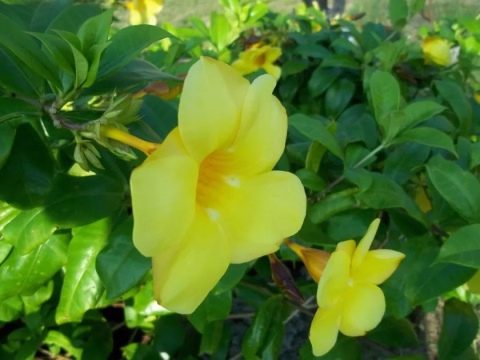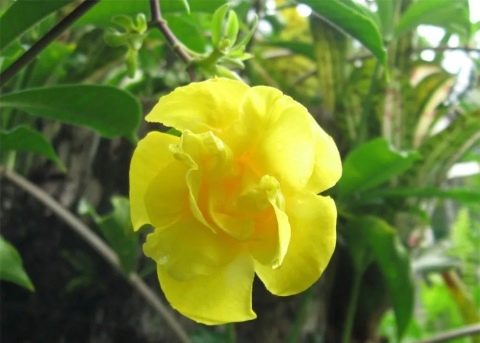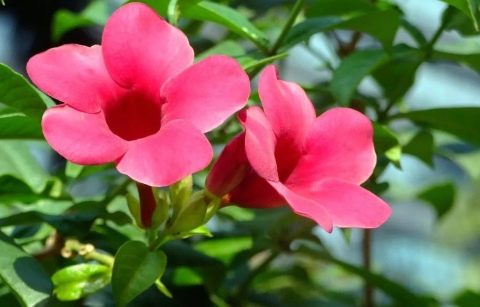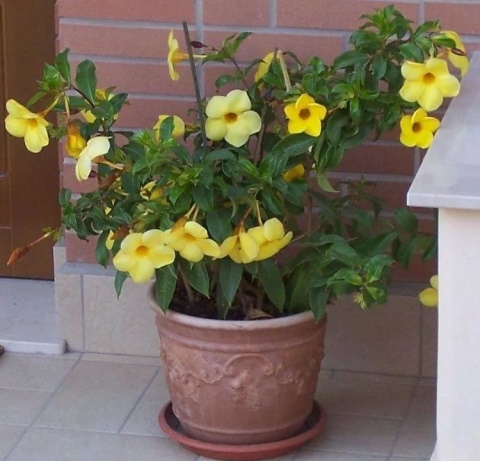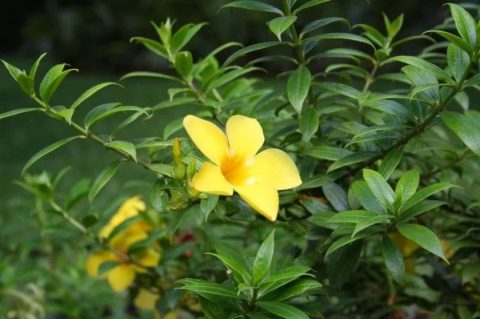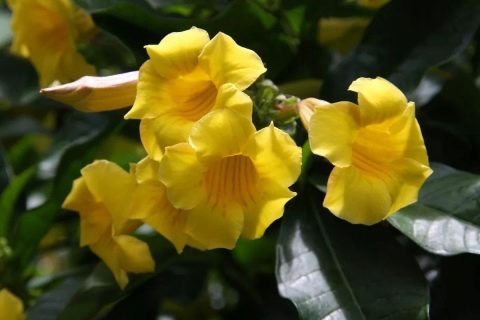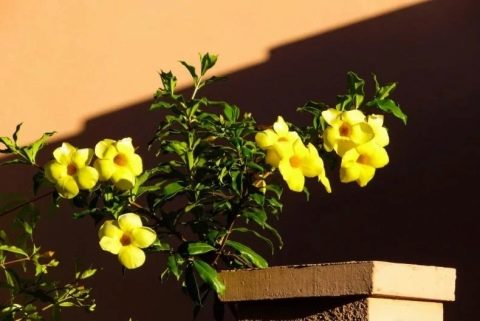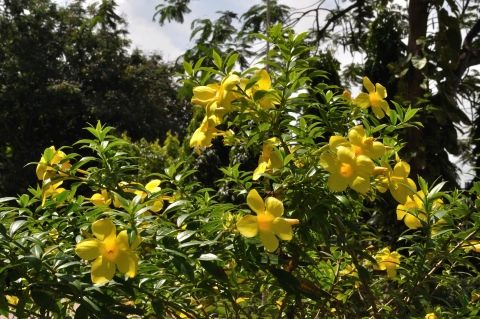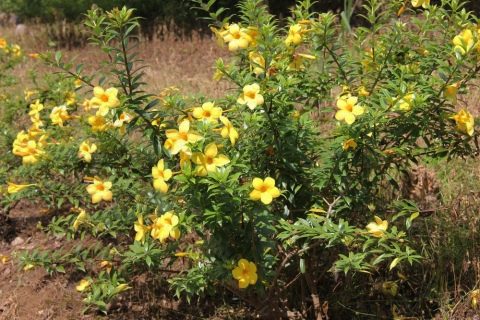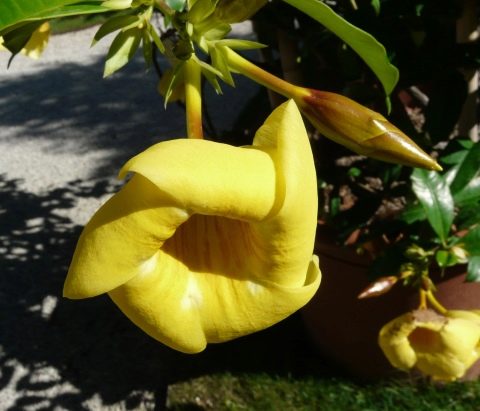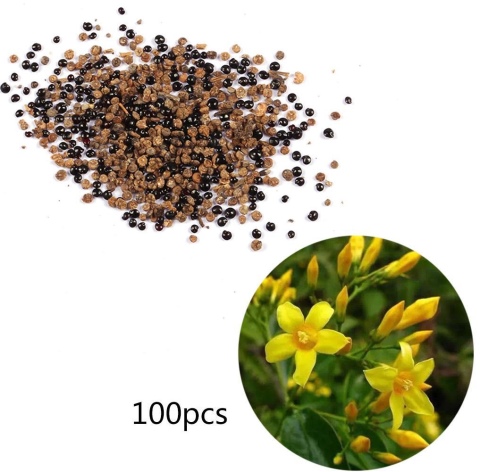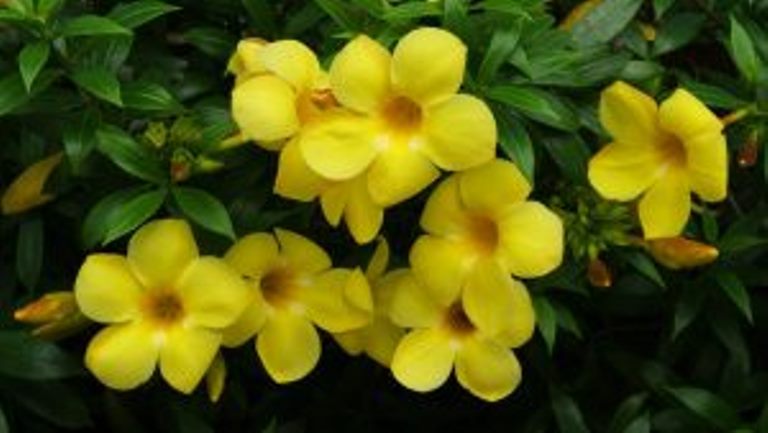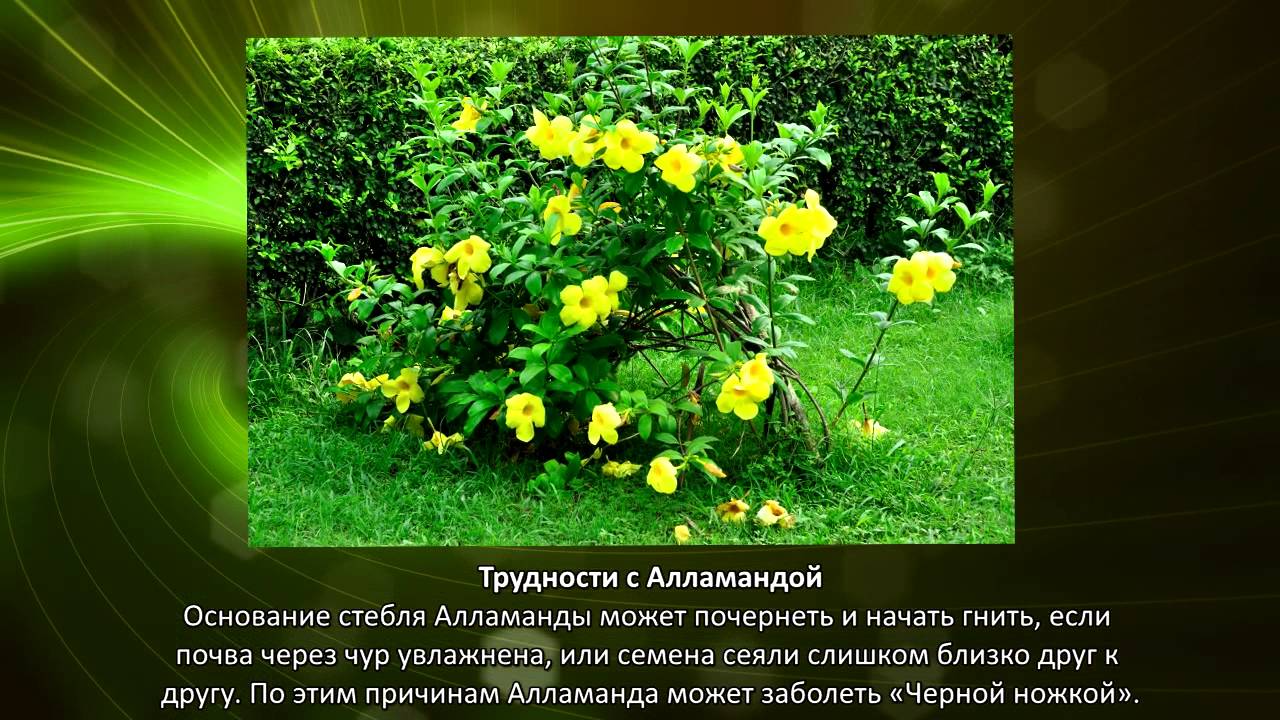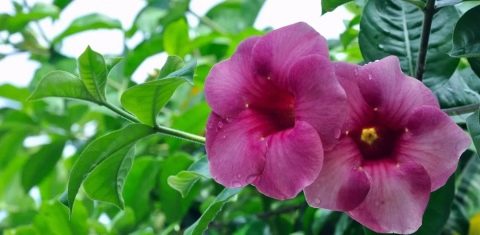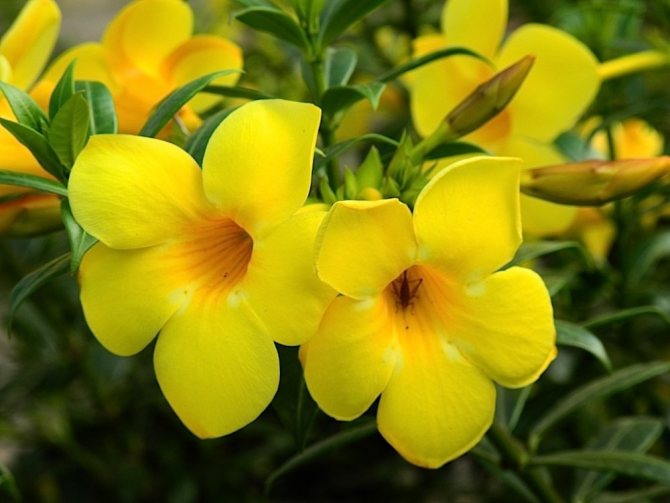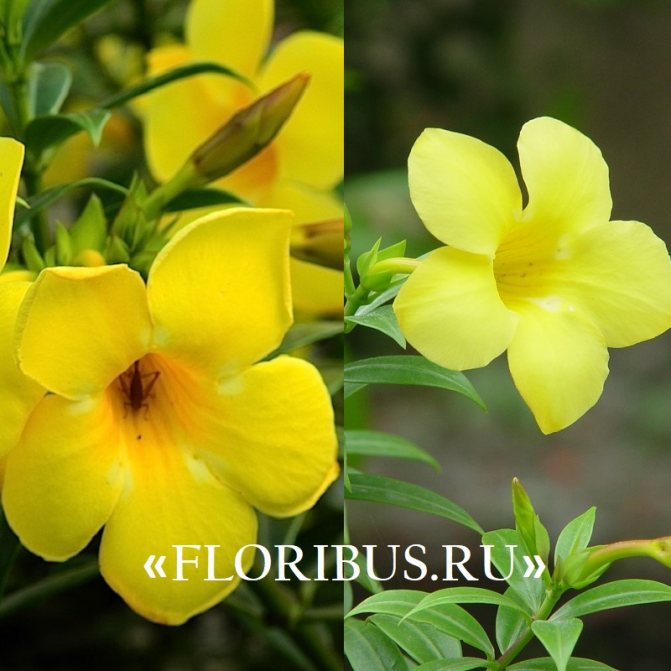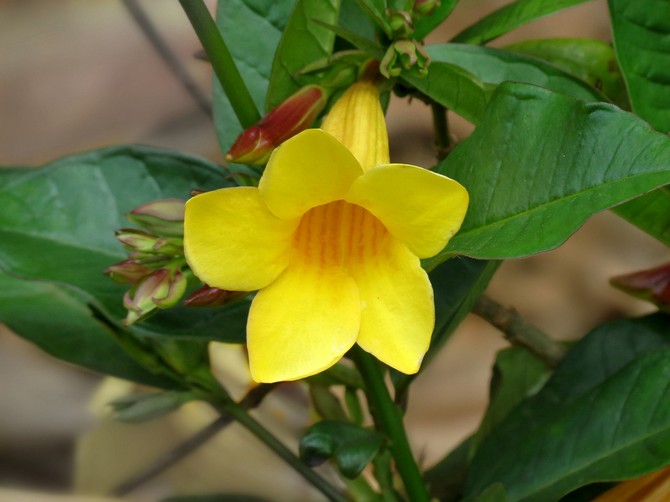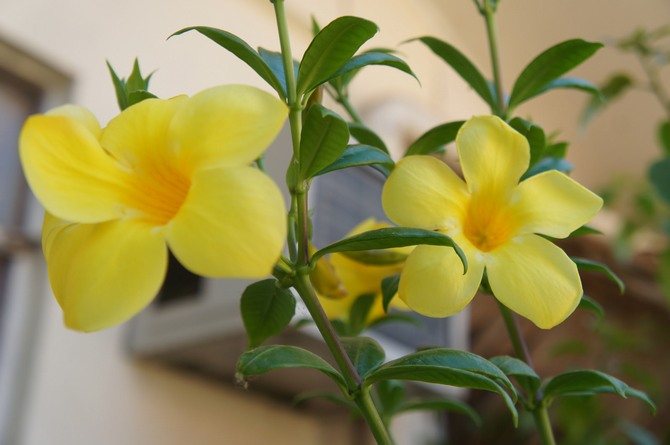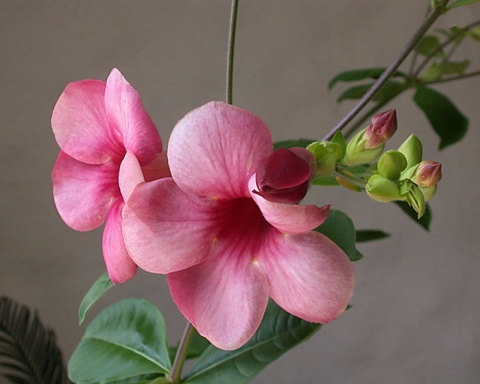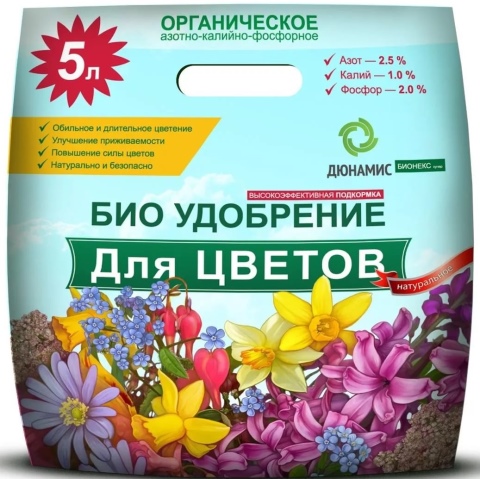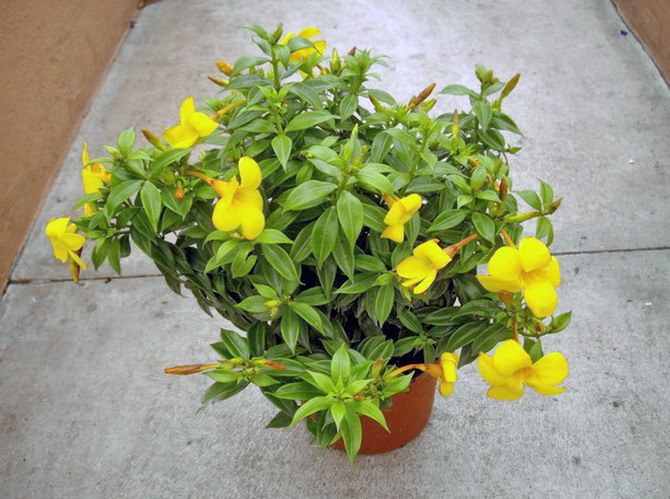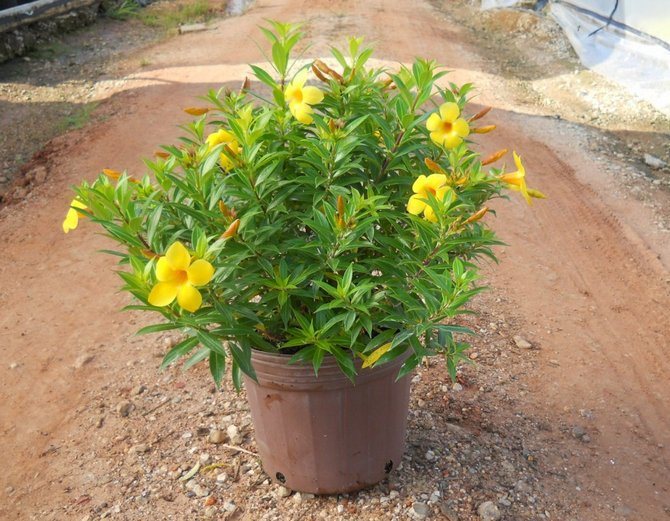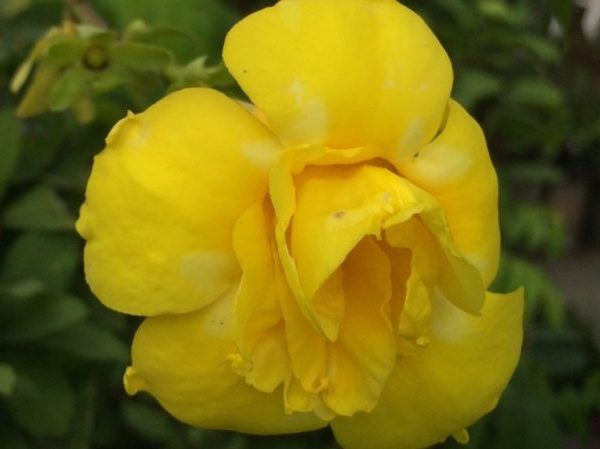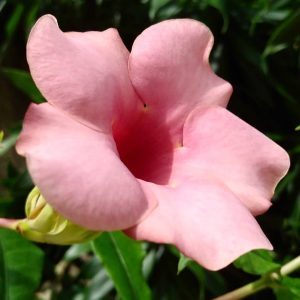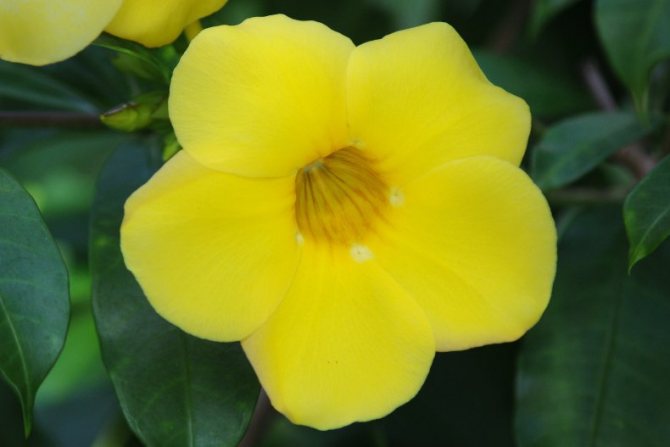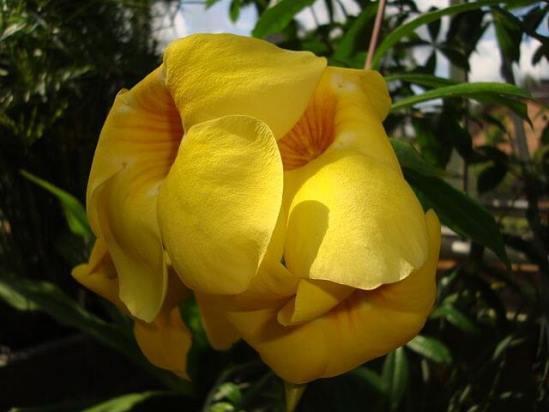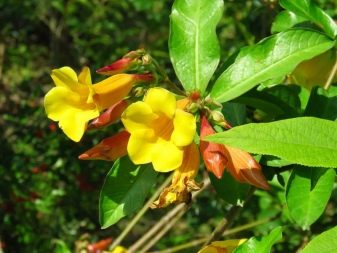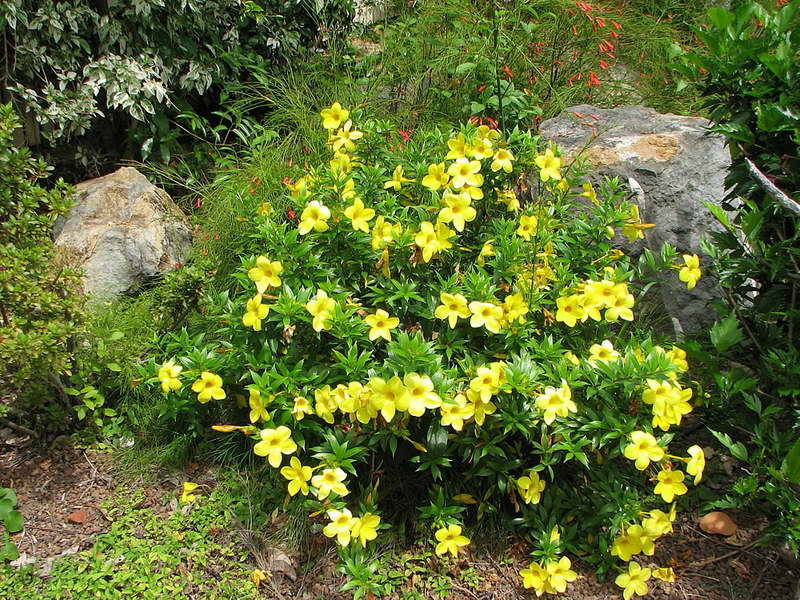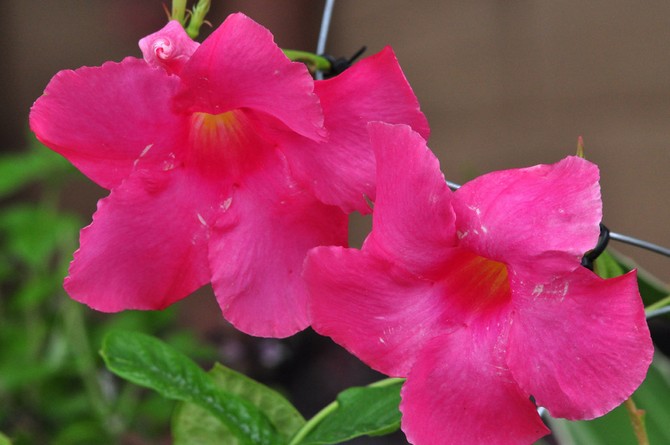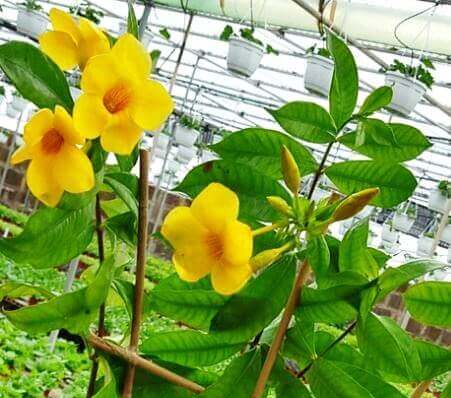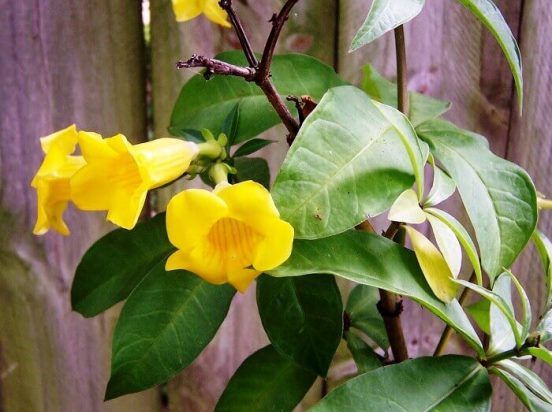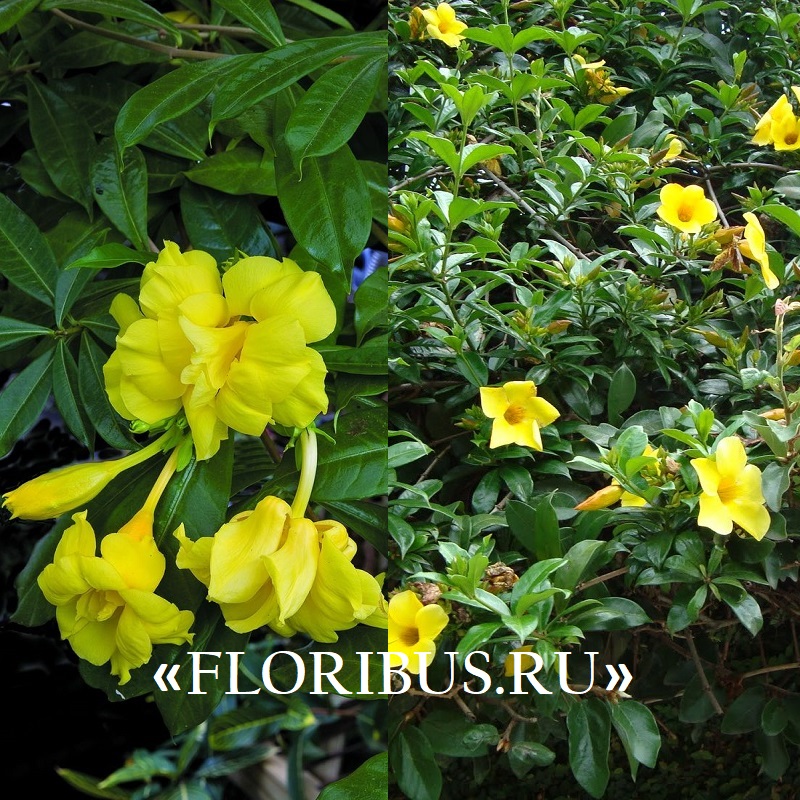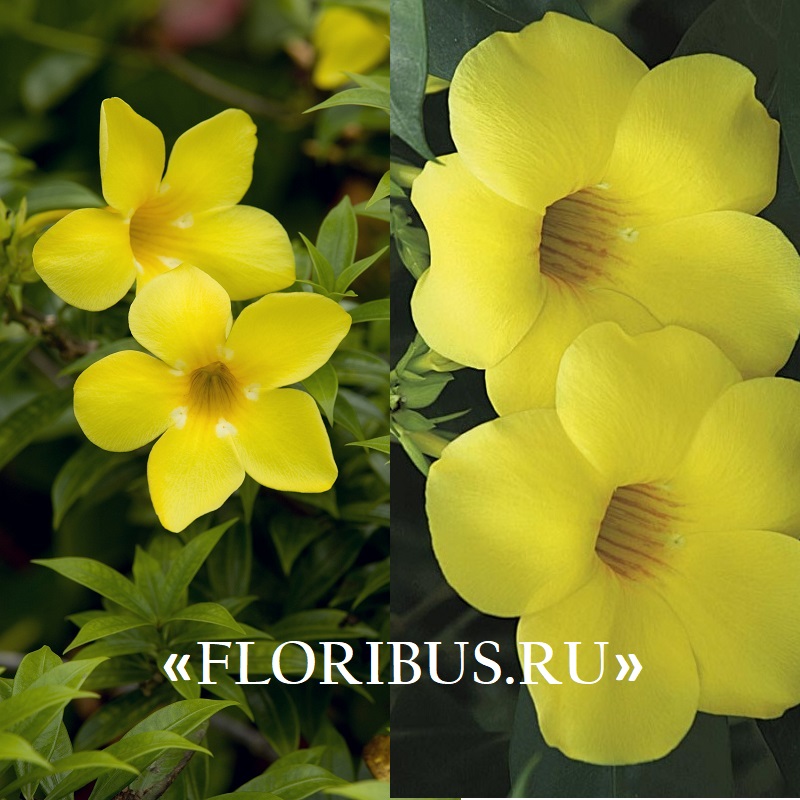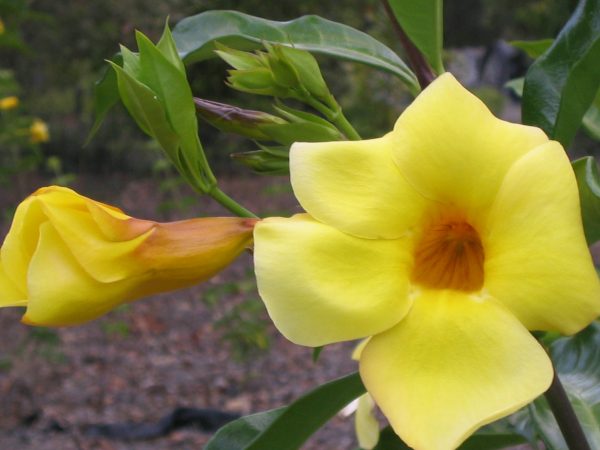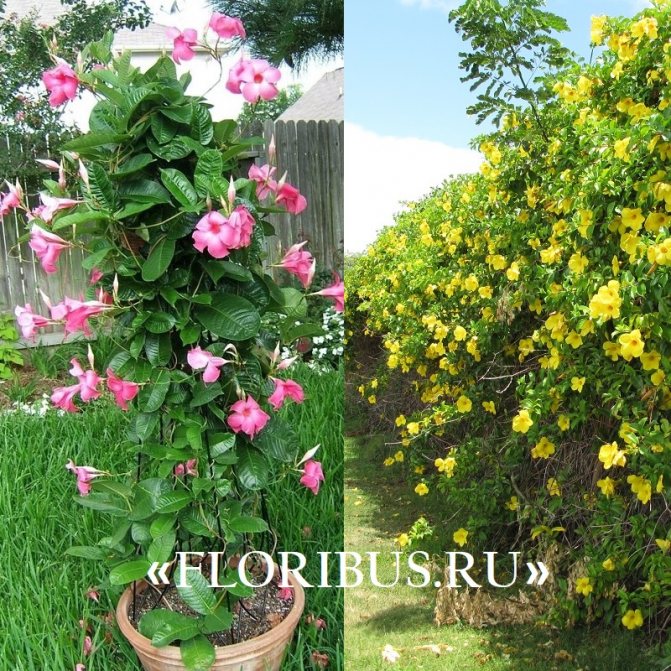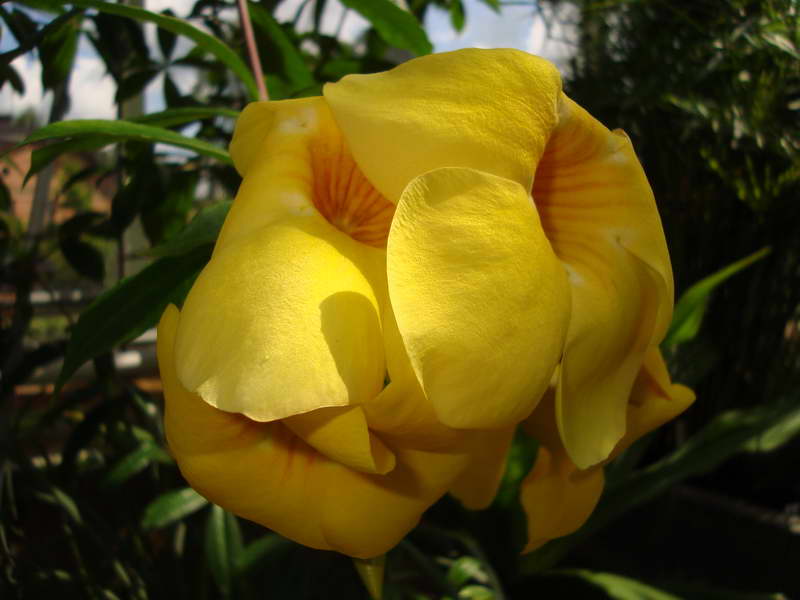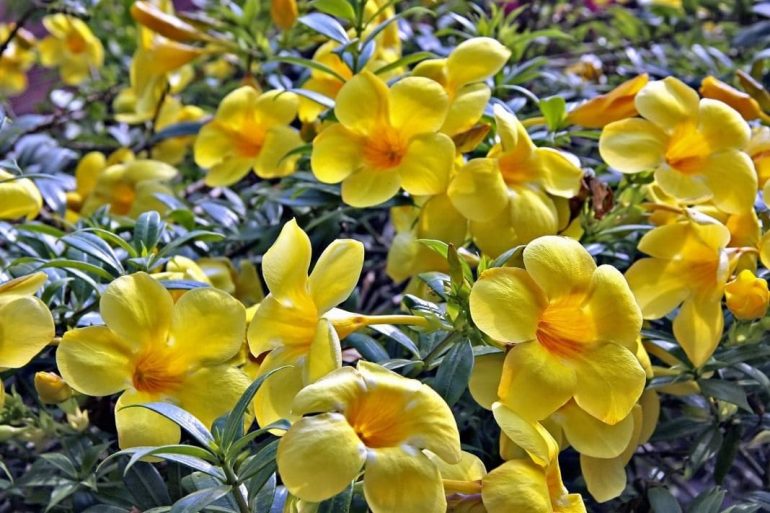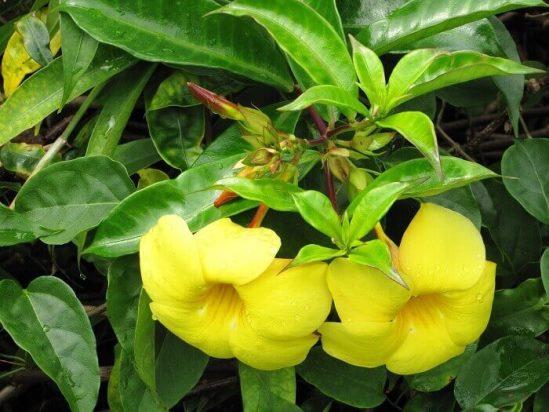Allamanda care
Lighting
Allamanda is very demanding on the level of illumination. She needs a lot of light. For indoor cultivation, allamanda is placed on the southern or eastern windowsill. Provided - the plant must be completely protected from drafts. In winter, the vine will need additional lighting. If Allamanda lacks light, it will never bloom.
Air temperature
Spring-summer: + 20, + 25 degrees.
Autumn-winter: + 15, + 18 degrees.
Humidity
Exotic flowers usually require high humidity. Allamanda is no exception. For its constant content, a moisture level of at least 60% is required. The plant must be sprayed daily, avoiding water getting on the flowers and buds. Alternatively, you can use a humidifier and sprinkle wet pebbles into the pan.
Watering
Allamanda quickly consumes moisture, you need to water it abundantly. Only the upper part of the substrate should dry out between waterings. With the onset of winter, watering is gradually brought to moderate
Excessive watering can very quickly lead to decay of plant roots, it is important to always observe the measure
Top dressing
From March to August, Allamanda is fed with fertilizer for flowering plants, every two weeks. The plant will be suitable for the concentration suggested by the feed manufacturer.
Transfer
A growing, young plant needs replanting every spring. It is enough to replant adult plants every 2-3 years. The soil is used universal for flowering plants. Transplanting can be combined with pruning to give the shoots a neater shape. To make the allamanda look beautiful, it is best to use additional supports to which the plant is tied up during transplantation.
Reproduction
If you don't often find rare indoor plants on sale in your city, you can grow them from seeds. Allamand seeds are sown in a sandy-peat substrate. The temperature inside the greenhouse is maintained at +25 degrees. Seeds should be regularly sprayed and ventilated. The first shoots will appear in 3-5 weeks.
Reproduction by stem cuttings is possible. For this method, choose semi-lignified cuttings, at least 10 cm long. The cut of the cuttings should be treated with a rooting stimulator and planted in wet sand. Under a jar or bag, rooting will happen much faster.
Pests
Correct and timely pruning is the key to the flowering of allamanda. It should be carried out at the very end of autumn. All shoots are cut in half.
Note. The plant needs support
Its shoots are weak and fragile, so they need to be tied up.
Reproduction of allamanda
The flower can be propagated both by seeds and cuttings. The seed propagation technology is nothing special and is similar to. Unless it is necessary to constantly maintain the temperature not lower than +22 degrees. Seedlings may appear in three weeks, but you may have to wait up to 6 weeks.
It is much easier and safer to propagate allamanda by cuttings (if there is a mother plant). Young semi-lignified cuttings from 7 to 10 centimeters long are suitable for reproduction. They can be pretreated in a solution of any stimulant (Kornevin, Heteroauxin, etc.). Warm and humid conditions should also be created for cuttings. Ideally, if a mini-plate is to be used.
The most favorable time for the breeding of Allamand is the end of winter - the beginning of spring.

Neoregelia: home care
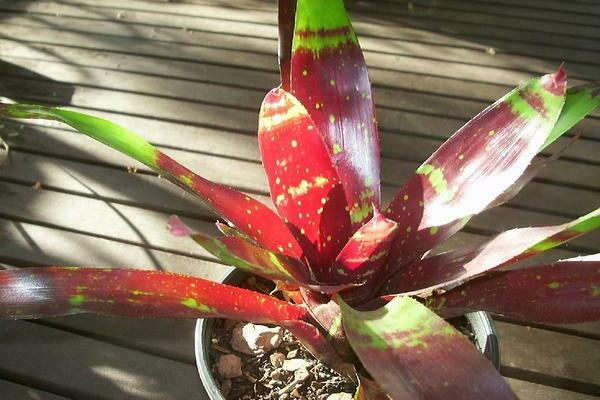
Neoregelia
Since the natural growing environment of neoregelia is characterized by high air humidity and high temperature indicators, when growing it at home, attention should be paid to the preferences of this tropical plant. Lighting mode
Lighting mode
Neoregelia belongs to light-loving crops, however, in conditions of dense tropical forests, it is not exposed to direct sunlight. For this reason, in indoor growing, daylight must also be diffused or reflected.Direct sunlight is especially dangerous on hot summer days, so you need to take care of shading neoregelia. In the autumn-winter period, on the contrary, the lighting should be as intense as possible. In order to eliminate the lack of light, you can equip the room with an additional lighting system.
Indoor air temperature
Neoregelia needs to constantly maintain a fairly high air temperature in the room where it is located - 20-25 degrees. In winter, it is recommended to move it to a cool room, in which the thermometer is at about 16 degrees Celsius. This will allow the plant to bloom for quite a long time - from a couple of months to six months.
Room humidification
Since the natural habitat of neoregelia is characterized by high air humidity, appropriate conditions must be created when growing it indoors. The optimum humidity in the room is at least 60%. The best solution would be to place neoregelia in a greenhouse or greenhouse. If this is not possible, you can use a room humidifier. There are also simpler ways to achieve the required level of moisture in the surrounding plant environment. For example, in the pallet on which there is a pot with neoregelia, you can pour expanded clay or lay it out with a layer of sphagnum moss, and pour a little water there.
In this case, it is important to exclude the possibility of contact of the bottom of the clay pot with moisture. You can also increase the humidity in the room by regularly spraying neoregelia with water at room temperature.
The foliage of the plant can be periodically wiped with a wet cloth. At high air humidity, ventilation of the room should not be neglected - this will avoid stagnation of moisture. It should be remembered that drafts are extremely dangerous for the health of a tropical plant.
How nigella breed
Growing Nigella Albin and all other varieties does not require effort and time. The plant can reproduce in several ways.
Planting seeds for seedlings
Spathiphyllum flower - reproduction at home
The seedling method of growing nigella is longer than the non-seedling method. However, it is he who is most often used by gardeners. Seeds should be sown in a greenhouse at the end of winter, a month and a half before the end of frost. For sowing, choose wide wooden or plastic boxes, which are filled with a universal substrate or a mixture of turf and sand.
Note! Seedlings can also be grown on the windowsill. Seeds in this case are also sown at the end of winter.
Seeds planted in the ground are sprinkled with sand, then sprayed with a small amount of water. From above, the boxes are covered with glass or polyethylene. The shelter must be removed daily to provide airflow to the seed. In the room where the box with future seedlings will be located, the temperature should be from 22 to 25 ° C, diffused lighting. The soil is sprayed as it dries.
Seedling care
The first seedlings appear two to three weeks after sowing the seeds. Then the shelter is removed for good, the temperature drops by a couple of degrees, that is, to 21-23 ° C. This measure prevents the seedlings from "pulling out". Its watering is carried out further by spraying until it is ready for transplanting into individual peat-humus pots.
Dive
Seedlings are dived after the appearance of real leaves.
Seedlings are transplanted very carefully, it is important not to damage the root system. If there are no peat-humus pots at hand, ordinary plastic cups are suitable, from which plants are then planted in open ground
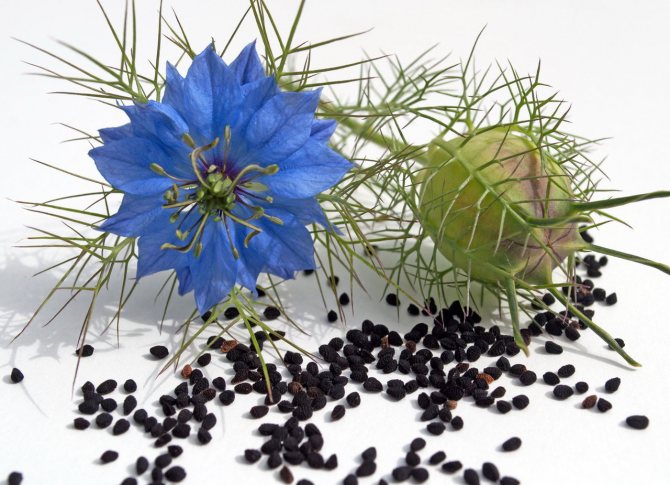
Seeds of Nigela Damascus
Seedless way
Nigella, planting and caring for which in the open field is not particularly difficult, can be grown in a seedless way.In this case, the seeds are sown in the garden in April-early May, but this can be done for the winter.
In one place, the seeds are sown from 3 to 4 times with an interval of 3-4 weeks. This ensures continuous flowering of the nigella throughout the summer. The soil is prepared in advance. It shouldn't be sour.
Note! Seedlings do not like changing places, so it is worth immediately planting seeds in a place where nigella will grow constantly. If Nigella was a perennial plant, it could be planted in a pot
However, in this case it is not recommended to do this. The best place for a plant is a garden bed
If Nigella was a perennial plant, it could be planted in a pot. However, in this case it is not recommended to do this. The best place for a plant is a garden bed.
Features of Crassula
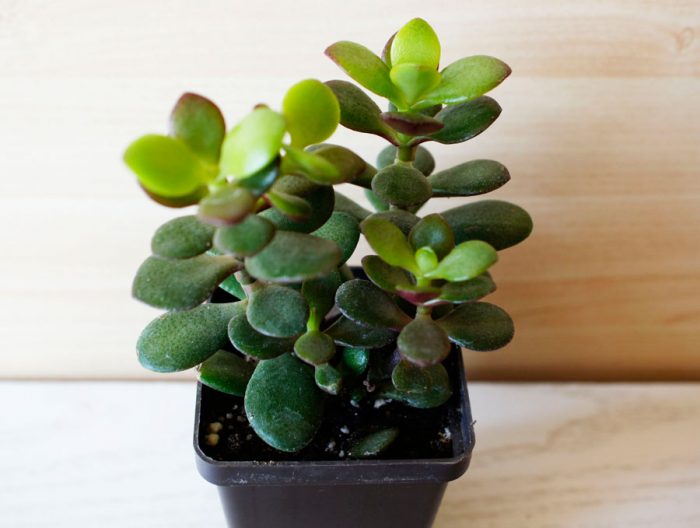
In culture, as well as in natural conditions, you can meet crassula represented by herbaceous and aquatic plants, tree-like shrubs, there are both very small succulents and large ones, but they have one common feature: on the shoot, their leaf plates are placed opposite each other crosswise ... Such a succulent plant, when grown in indoor conditions, has a smaller size compared to those specimens that grow in nature, the fact is that such a crassula is limited by the volume of soil mixture, space and other conditions that are needed for active growth. However, over time, such a flower still becomes a tree with a thick stem. The leaf plates are entire and simple, in some species they are ciliate. Lateral or terminal inflorescences can be racemose or umbellate-paniculate, they include flowers of yellow, red, white or pale blue color. But it should be borne in mind that in indoor conditions the fat woman almost never blooms. This culture is very popular among flower growers due to the fact that it is unpretentious, hardy and very easy to care for.
1. Seven Secrets of Success:
| 1. Growing temperature: throughout the year from 18 to 27 ° C. |
| 2. Lighting: at least 4 hours of direct sunlight daily - morning and evening. |
| 3. Watering and humidity: dry the soil a few centimeters deep between waterings, it is advisable to increase the air humidity. |
| 4. Pruning: formative, carried out in the spring. |
| 5. Soil: nutritious, with good drainage. |
| 6. Top dressing: during spring and summer with mineral fertilizers every 2 weeks. |
| 7. Reproduction: apical cuttings in spring and summer. |
Botanical name: Allamanda.
The allamanda plant is a family.
Origin. Brazil
Description. Allamanda is a laxative - this tropical evergreen plant has long stems densely covered with glossy, dark green oval leaves, 3-4 leaves in a whorl. Inflorescence is an apical brush. The buds appear in the summer at the ends of the stems, open with yellow tubular flowers up to 10 cm in diameter. Support the plant as its flexible stems grab onto it and easily twist around the trellis. This plant requires a lot of heat, moisture and light.
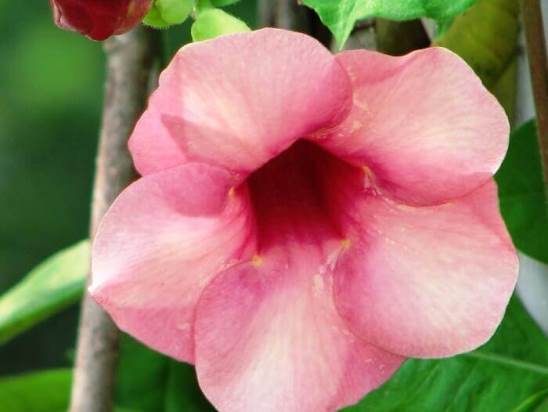
Height. Up to 2.4 m if not trimmed. There are dwarf varieties with a height of about 38 cm.
Features of Jacobin care
Lighting and temperature
At home, Jacobinia requires bright, diffused light. The eastern and western expositions will be the ideal growing place. On the south side of the window, the flower requires shading from daytime sunlight from mid-spring to October.
 Yellow jacobinia
Yellow jacobinia
In late autumn and winter, it is advisable to provide the plant with at least 3 hours of directed light, therefore, the use of a phytolamp is relevant on cloudy days.
The optimum air temperature for justice is 20-25 ° C.From mid-autumn, you can gradually lower the temperature to winter values in the range of 12-16 ° C, which will allow the plant to rest and gain strength before flowering.
In summer, it is recommended to take the bush out into fresh air or ventilate the room more often.
Watering and humidity
Caring for Jacobinia at home includes proper watering. The plant belongs to moisture-loving crops that need frequent irrigation during the growing season.
However, the stagnation of water in the soil causes the development of root rot, therefore, it is watered only after the upper soil layer dries up 0.5-1 cm deep, about once every 3 days.
As the temperature in the room decreases, watering is gradually reduced, and in winter it is watered every 10-14 days. The tropical exotic reacts to the lack of moisture by drying, falling foliage and flowers.
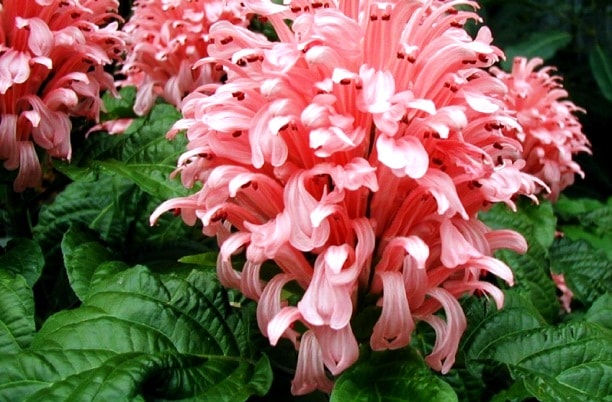
Room humidity should be 50%. It is easy to raise it - put the pot on a dish with wet pebbles or / and often spray the leaves, avoiding getting on the inflorescences.
In summer, in the heat, it is recommended to spray water in the morning and afternoon, in winter it is possible every other day. It is also advisable to regularly wipe the leaves of the plant from dust with a damp cloth.
Pay attention to the quality of the water, which must be soft (settled, rain, melt) and room temperature
Transplant and feeding
The bush is transplanted every 2-3 years, but young seedlings need an annual transplant for the first 2 years. The soil should be loose and breathable, therefore sand or vermiculite should be added to the universal flower soil in a ratio of 3: 1. The pot must have holes for draining excess water and a 5 cm high expanded clay drainage layer.
During transplanting, carefully, as much as possible, shake off the old soil from the root system, but so as not to damage the roots. After the procedure, the plant is watered and a shaded place is placed for 2-3 days.
In the absence of nutrients, the lower leaves of domestic Jacobinia become pale and begin to fall off, therefore regular feeding during the period of active growth for flowering ornamental crops is important for the health of your green pet.
Fertilizer is well suited for pelargonium or sulfinium, the minerals in which are specially balanced and easily assimilated. They are fed every 3-4 weeks, diluting the fertilizers in water for irrigation.
Pruning
Since flowers are formed on the shoots of the current year, it is better to prune in early spring, shortening the branches by 10-12 cm. The procedure stimulates tillering and abundant flowering.

Old shrubs with elongated, unattractive shoots are rejuvenated by radical pruning. All branches are shortened, leaving only one dormant bud above the ground on each shoot. As it actively grows, each such bud will give at least 2 new shoots.
Reproduction of Jacobinia at home
Jacobinia reproduces well with apical cuttings, which can be taken after pruning. Cuttings are cut with a sterile instrument at an angle of 45 degrees just below the leaf node. Leaves from the bottom are removed, leaving only the top pair.
The cut of the cutting is dipped in a root growth stimulator powder, then planted in a mixture of perlite and soil (1: 1). Cover with a transparent bag.
Maintain soil moisture, but do not allow stagnation of water, spray the ground part with warm water. Remove the bag periodically for ventilation.
 Justice from the cutting
Justice from the cutting
A month after the appearance of new shoots, young plants can be transplanted into fertile soil. Pinch the tips of the shoots as they grow to enhance tillering.
Growing problems
The culture is resistant to diseases and problems in the care of Jacobinia are associated in the overwhelming majority of cases with improper growing conditions.
Leaves dry up and fall off if there is insufficient or excessive watering. Drafts and too low temperatures also cause foliage to fall.
The lack of bloom is caused by a lack of lighting. Flowers rot and fall off - the result of contact with water when splashing or due to insufficient air ventilation. Leaves become pale when there is a deficiency of nutrients in the soil.
Of the pests, Jacobinia is susceptible to attack by spider mites and whiteflies.
Names and characteristics of species and varieties of gravilata (with photo)
There are about 50 types of gravilat, of which no more than 20 are used in ornamental gardening. Some types and varieties of gravilat are described below.
Perennial herb about 70 cm high. Steles are straight, strong, dark green with a reddish tint, covered with hard hairs. The leaves are collected in a basal rosette, kept on long petioles. They consist of 3 - 6 pairs of wedge-shaped small leaves with dense pubescence. The flowers are numerous, yellow.
According to botanical characteristics, mountain gravilat is a perennial herb with a height of 30 - 40 cm.
The leaves are dark green, wrinkled, slightly pubescent. The flowers are cupped, yellow, 2.5 cm in diameter.
Bloom from May to June. This species can withstand low temperatures up to -30 degrees. Suitable for growing in central Russia.
A spectacular plant up to 60 cm high with a pubescent stem and bright red, rarely orange double or semi-double flowers. The leaves are collected in a root rosette. Flowers up to 3 cm in diameter. Blooms in mid-May and blooms until mid-June.
Herbaceous perennial plant up to 30 cm high. Has tough, branched, pubescent stems. The flowers are small, white. The length of the bud is 1 cm.
Perennial flower Chilean gravilat reaches up to 60 cm in height, has a straight stem and leaves formed into a root rosette. The flowers of the species are small, red, collected in a paniculate inflorescence. Blooms from late June to mid-July.
It is a perennial herb that grows in dense groups. Its height is no more than 30 cm.
The flowers are yellow-purple with drop-shaped pointed petals. At the end of flowering, white-burgundy seeds with a long tail are formed.
Gravilat urban - perennial flowers, reaching 20-60 cm in height, with a short reddish-brown branched rhizome located shallow in the soil. Stem erect, branched at the top, softly roughly hairy.
Basal leaves on petioles, lyre-shaped, pinnately divided, with a larger terminal lobe, stem leaves are almost sessile, tripartite. The flowers are five-membered, the petals are yellow, the columns are long, preserved in fruits. It blooms in May-June, the fruits ripen from the beginning of June. Propagated by seeds, in the distribution of which animals and humans are involved, and vegetatively, when the old part of the rhizome dies off, 44 separate branches with dormant buds are separated from each other to form a clone. The plant is anthropotolerant, withstands significant anthropogenic loads. One of the most common plants in the reserve, it is found in most terrestrial communities.
Herbaceous perennial plant, widespread throughout Europe and most of Russia. Stem erect, 18 to 45 cm high. Basal leaves are pinnate, with a very large, rounded, sometimes 3-lobed terminal leaflet and small lateral leaflets; stem leaves are trifoliate or 3-partite.
Flowers drooping. The calyx is 5-partite, adherent to a short-cylindrical rough receptacle, with a subdivision of 5 small leaves. The calyx and the upper part of the stem are red-brown. Petals 5, reddish-white, with reddish veins, obovate, notched in front, narrowed at the base into a marigold.
The pistil consists of numerous carpels on the cylindrical-conical elevation of the receptacle. The column is long, remaining with a part articulated with it and bent to the side. The fruit is dry, consisting of achenes, raised on a stalk, as long as the calyx with its upward lobes.Perennial gravilat water grows near streams, along the banks of rivers and lakes, in wet meadows and in damp forests. It blooms from May to July, the seeds ripen from July to September, depending on the climate.
A perennial plant, which is a low compact bush about 30 cm wide. The flowers are yellow-red, drooping, resembling a bell in shape. The buds are formed at the top of the peduncles.

